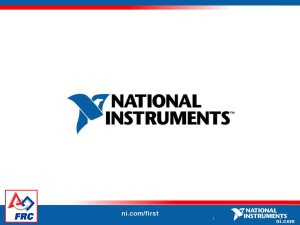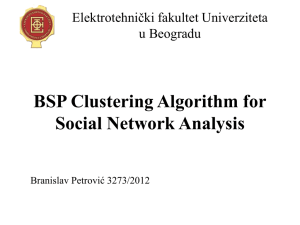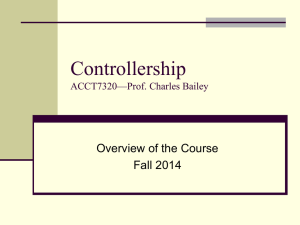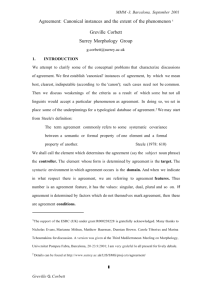Lecture 13 - State Feedback
advertisement
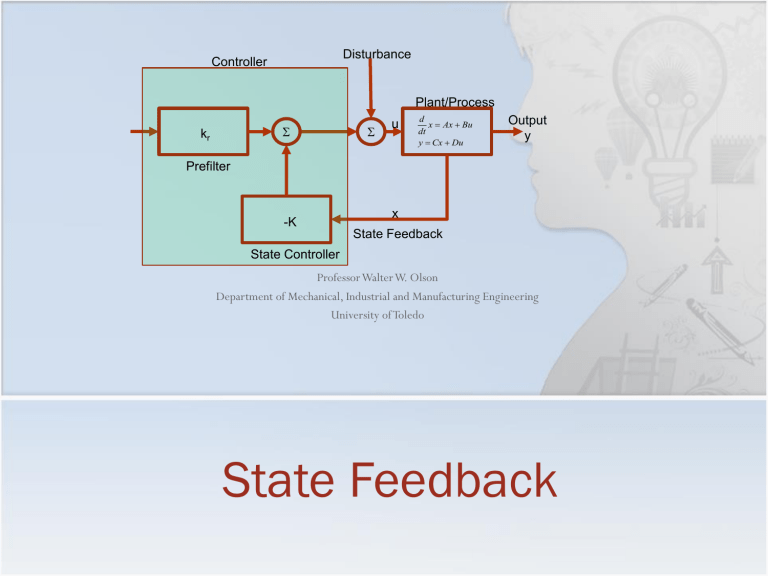
Disturbance Controller Plant/Process S kr S u d x Ax Bu dt y Cx Du Output y Prefilter -K x State Feedback State Controller Professor Walter W. Olson Department of Mechanical, Industrial and Manufacturing Engineering University of Toledo State Feedback Outline of Today’s Lecture Review Reachability Testing for Reachability Control System Objective Design Structure for State Feedback State Feedback 2nd Order Response State Feedback using the Reachable Canonical Form Reachability We define reachability (often times called controllability) by the following: A state in a system is reachable if for any valid states of the system, say, initial state at time t=0, x0 , and a state xf , there exists a solution for t>0 such that x(0) = x0 and x(t)=xf. There are systems which we can not control the states are not reachable with our input. There in designing control systems, it is important to know if the system is controllable. This is closely linked with the concept of ergodicity of the system in which we ask the question whether or not it is possible to with some measure of our system to measure every possible state of the system. Reachability For the system, , d x Ax Bu dt and y Cx Du all of the states of the system are reachable if and only if Wr is invertible where Wr is given by Wr B AB An 1 B Canonical Forms The word “canonical” means prescribed In Control Theory there a number transformations that can be made to put a system into a certain canonical form where the structure of the system is readily recognized One such form is the Controllable or Reachable Canonical form. Reachable Canonical Form A system is in the reachable canonical form if it has the structure z1 a1 a2 a3 ... an z1 1 z 1 0 0 ... 0 z2 0 2 d z3 0 1 0 0 z3 0 u dt ... ... ... ... ... 0 zn 0 0 0 1 0 zn 0 y c1 c2 c3 ... cn z Du Such a structure can be represented by blocks as D u S -1 S S c1 c2 z1 … … z2 a1 a2 S S S S cn-1 cn zn-1 an-1 … S zn an y Control System Objective Given a system with the dynamics and the output d x Ax Bu dt y Cx Du Design a linear controller with a single input which is stable at an equilibrium point that we define as xe 0 Our Design Structure Disturbance Controller Plant/Process Input r kr S S u d x Ax Bu dt y Cx Du Prefilter -K x State Feedback State Controller Output y Our Design Structure Disturbance Controller Plant/Process Input r S kr S u d x Ax Bu dt y Cx Du Output y Prefilter x -K State Feedback State Controller Ignoring the disturbance u Kx k r r d x Ax BKx Bk r r ( A BK ) x Bk r r dt Therefore, our new system equations are d x ( A BK ) x Bk r r dt y C DK x Dk r r d x ( A BK ) x Bk r r If D 0 as it mostly is, then dt y Cx Restated Control System Objective (Eigenvalue Assignment Problem) Given a system with the dynamics and the output d x Ax Bu dt y Cx Du Design a linear controller with a single input which is stable at an equilibrium point that we define as xe 0 with a state feedback controller such that d xe ( A BK ) xe Bk r r dt y Cxe where the eigenvalues of ( A BK ) all have negative real components Note that kr does not affect stability, is a scalar, and can be chosen as kr 1 C ( A BK ) 1 B for ye=r Example Design a controller that will control the angular position to a given angle, 0 3998.35 0 30 A B 0 1 0 119950 30 119950 AB Wr B AB 30 30 0 0.0333 133.3 Wr 1 states are reachable 0.0333 0. 3998.35 0 30 3998.35 30 K1 A BK K1 K 2 1 0 0 1 The characteristic polynomial for the system is I A 30 K 2 3998.35 30 K1 2 n 2 2n 2 n 30 K 2 From Lecture 5 and with values: bRa KK b d JRa dt 1 K 0 JRa Va 0 0 y 0 1 Ra 0.2 K b 5.5 10 b 4 10 2 2 V-s/rad N-m/rad/s 2 30 K 2 If n 1 and .6 then 2 30 K 2 3998.35 1 0.0333 and K1 133.185 30 30 K 133.185 0.0333 K2 kr J 1 105 kg-m 2 K 6 105 N-m/amp 3998.35 30 K1 kr 1 C ( A BK ) 1 B 1 1 -1.3500 -1.0000 30 0 1 0 0 1.0000 1 1.0000 30 0 0 1 -1.0000 -1.3500 0 0.0333 30 K 2 0 Example Design a controller that will control the angular position to a given angle, 0 K 133.185 0.0333 k r 0.0333 This results in the system d -1.3500 -1.0000 1 r 0 0. dt e 1.0000 y 0 1 e 2nd Order Response As the example showed, the characteristic equation for which the roots are the eigenvalues allow us to design the reachable system dynamics When we determined the natural frequency and the damping ration by the equation I A 30K2 3998.35 30K1 2 n 2 2n 2 we actually changed the system modes by changing the eigenvalues of the system through state feedback n=1 0.6 Im() 0.1 1 0.4 x xx 0.6 x 1 1 x 0 Re() x -1 0.6 x 0.4 x xx 0.1 0 -1 Im() x n=4 1 n=2 x n=1 x n -1 n=2 x n=4 x x n=1 -1 Re() State Feedback Design with the Reachable Canonical Equation Since the reachable canonical form has the coefficients of the characteristic polynomial explicitly stated, it may be used for design purposes: z1 a1 z 1 2 d z3 0 dt ... ... zn 0 a2 a3 ... 0 0 ... 1 0 ... 0 0 1 y Cz a1 k 1 z1 z 1 2 d 0 z3 dt ... ... 0 zn K k 1 k2 an z1 1 0 z2 0 0 z3 0 u ... ... 0 0 zn 0 a2 k 2 a3 k 3 ... 0 0 ... 1 0 ... 0 0 1 an k n z1 k r 0 z2 0 z3 0 r 0 ... ... 0 zn 0 0 y Cz k 3 ... k n Since K is applied to z Tx the control action is KTx or K KT Example: Inverted Pendulum Design a controller that will stabilize the Segway forward velocity at a given position, r0 Using the model developed in Lecture 5 for the inverted pendulum 0 0 x J ml 2 m2l 2 g 0 0 v J ( M m ) Mml 2 J ( M m ) Mml 2 F 0 0 1 0 mlg ( M m ) ml 0 0 2 J ( M m ) Mml J ( M m ) Mml 2 M 10kg x v m 80kg y 0 1 0 0 with l 1m J 100kg m 2 / s 2 0 x 0 d v dt 0 0 1 0 From Lecture 12: The characteristic polynomial of A is I A 4 7.205 2 0 1 0 7.2051 0 1. 0 7.2051 Wr 1. 0 0 0. 0. 1. 0 0. z1 z1 0 7.205 0 0 1 z2 0 0 0 0 d z2 1 z3 u 1 0 0 0 dt z3 0 ... 0 1 0 0 z4 0 zn y Cz The eigenvalues are 2.684, -2.684, 0, 0 Note the system is unstable and that the only pair of eigenvalues is at 0 (undamped!) Our objective then would be to stabilize the system and add some damping, say =0.6 Example Starting with the characteristic equation we can write it as I A 2 2 7.205 If we regard this a combination of two 2nd order systems in which one acts extremely slow ( 2 ) and the other faster but unstable 2 7.205 then we want to dampen the slow system with eigenvalues in the unit circle to maintain speed but with a damping ratio of about =0.6: Re( ) 0.6 0.6 .62 x 2 1 x .4 0.632 1 We have one eigenvalue (-2.684) which is acceptible but we need to move the other to the approximately -3 so that I A 1 i 0.632 1 i 0.632 +2.684 3 I A 4 7.683 3 20.81 2 24.05 11.26 K [7.683 0 20.81 7.205 24.05 0 11.26 0] K 7.683 28.015 24.05 11.26 0 0 122.5 0 0 0 122.5 0 K 7.683 28.015 24.05 11.26 12.491 0 28.10 0 0. 28.10 0. 12.491 K 140.6, 300.4, 3748, 1617 Using T developed from Lecture 12 1 7.0864 C ( A BK ) 1 B The new controlled system is kr d x ( A BK ) x Bk r r dt 1. 0. 0. 0. 0. 2.5834 5.5177 62.442 29.702 0.1302 d x r x 0. 0. 1. 0. 0. dt 1.1482 2.452 23.393 13.201 0.05785 Summary Control System Objective Design Structure for State Feedback Disturbance Controller State Feedback Plant/Process Input r d x ( A BK ) x Bk r r dt y C DK x Dk r r S kr S u d x Ax Bu dt y Cx Du Output y Prefilter x -K State Feedback State Controller 2nd Order Response State Feedback using the Reachable Canonical Form a1 k 1 z1 z 1 2 d 0 z3 dt ... ... 0 zn a2 k 2 a3 k 3 ... 0 0 ... 1 0 ... 0 0 y Cz 1 an k n z1 kr 0 z2 0 z3 0 r 0 ... ... 0 zn 0 0 Next: State Observers



